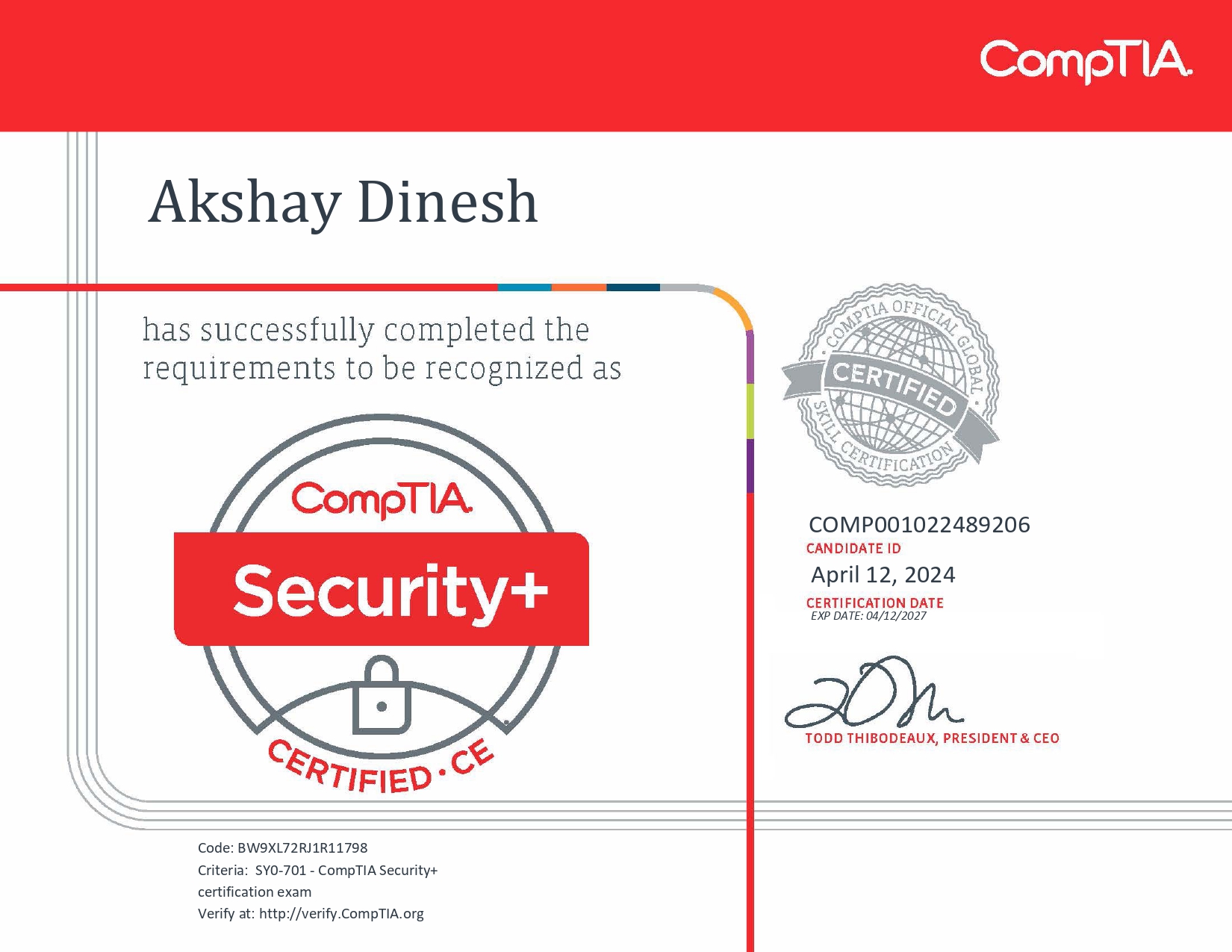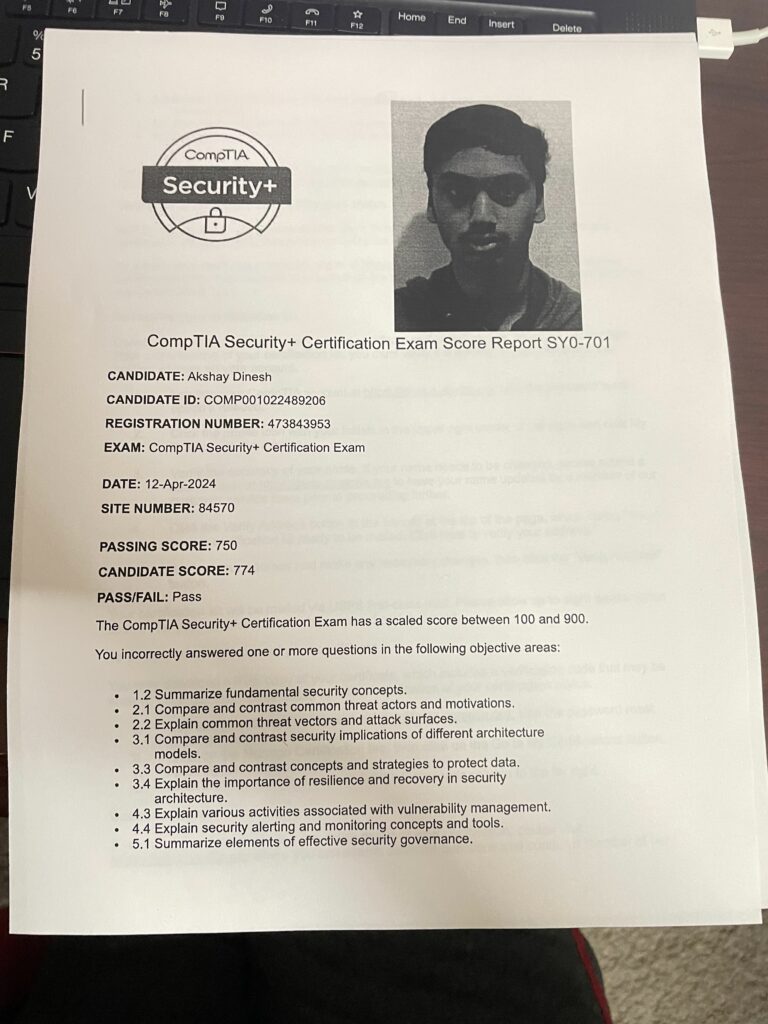How I Passed the CompTIA Security+ SY0-701 Certification as an 11th Grader

When I started my Advanced Cybersecurity class in 11th grade, I was really excited. I had always been interested in computers and security, but I had never thought seriously about getting a professional certification. Toward the end of the year, my teacher told us that we would be taking the CompTIA Security+ SY0-701 exam as our End of Pathway (EOPA) exam. At first, I thought that sounded cool — until I started looking into what the Security+ actually covered. It is a certification that even adults with IT experience find challenging. I realized really fast that this was not going to be some basic test you could pass just by cramming for a few days.
Honestly, I had no real expectations going into it. I figured I would try my best, but I was already preparing myself for the possibility that I might not pass. I knew how serious the Security+ was, and the idea of taking it as a high school student felt pretty intimidating. But at the same time, I thought even just trying would be a good experience, and if I did pass, it would be a huge bonus.
Realizing I Had to Study on My Own
Even though the Advanced Cybersecurity class covered important topics like networking, basic security principles, and threat types, it quickly became clear that the Security+ exam went way beyond what we had time to learn in class. The exam expected you to know risk management frameworks, cloud security models, incident response plans, encryption standards, and a lot more. Our class gave me a solid foundation, but it was not enough by itself to prepare me for the full scope of the certification.
Because of that, I started studying on my own as soon as possible. I used a lot of free resources like Professor Messer’s SY0-701 videos, which were super helpful because he explained things clearly without making it feel overwhelming. I also bought Jason Dion’s practice exams on Udemy. Those were honestly a game changer for me because the questions were structured in a way that felt similar to what I later saw on the actual exam. My strategy was simple: watch videos during the week, do flashcards whenever I had downtime during the day, and take full-length practice tests on the weekends to track my progress.
Preparing for the Big Day
Since everyone in our class had to schedule their exam individually, we were all on different timelines. I decided to schedule mine for April 12th since it was a Friday, and the days leading up to it weren’t too busy with other classes or homework, so I knew I’d have extra time to study and review everything properly. As the date got closer, I was feeling a mix of nervousness and excitement. Some days I would do really well on a practice test and feel ready, and other days I would completely bomb one and feel like I was back at square one.
The week before my test, I took a full practice exam and scored around 70 percent. That was close but not quite at the level I needed to feel confident, since the passing score was 750 out of 900. I focused hard on my weaker areas, like governance, risk management, and the different types of attacks and vulnerabilities. I also reviewed performance-based questions, since I knew they would show up and would be more hands-on than just picking multiple-choice answers.
Test Day Experience
On the day of my exam, I went to a local Pearson VUE testing center. The check-in process was pretty simple — they just asked for my ID, verified my appointment, and led me to the testing room. There was no crazy security process like rolling up sleeves or emptying pockets. It was a pretty straightforward experience, which actually helped calm my nerves a little bit.
Once I sat down at the computer and started the exam, I realized right away that it was no joke. There were 77 questions (if I’m recalling correctly), and you get 90 minutes to complete them. Some of the questions were multiple choice, but others were performance-based, where you had to apply your knowledge to real-world scenarios like configuring firewall rules or identifying the correct incident response steps. A lot of the questions were worded carefully to try to trip you up if you were not paying attention. I tried to stay calm, mark the ones I was unsure about, and keep moving.
Seeing the Score
When I finished the last question and clicked submit, I was so nervous that I almost did not want to look at the screen. After a few seconds, my score popped up: 774. I had passed! It honestly took me a moment to believe it. I had gone into the exam thinking that I might not pass at all, and somehow I had not just passed, but passed with a solid margin above the 750 minimum. It felt incredible to realize that all the hours of studying, reviewing, and practicing had actually paid off.

What I Learned From the Experience
Passing the Security+ taught me way more than just cybersecurity concepts. It taught me how to manage my time better, how to stay motivated when things got tough, and how to push through even when I doubted myself. There were definitely times when I thought about giving up or wondered if I was wasting my time. But sticking with it showed me that consistent effort, even when things feel overwhelming, really does pay off.
It also showed me that even if a class does not cover every single thing you need for a big certification exam, it can still give you the starting point you need. Our Advanced Cybersecurity class helped me build a foundation, but passing the exam was about taking that base and putting in extra work on my own. It felt good to realize that with the right mindset, you can learn way more independently than you might expect.
Moving Forward
Having the Security+ certification already at 17 years old is opening a lot of doors for me. I am starting to apply for cybersecurity internships this summer, and having a professional certification on my resume really makes me stand out. It also made me more confident about my future plans. I am thinking about studying for even more certifications, like the CySA+ or maybe the Certified Ethical Hacker (CEH) exam once I get more experience.
Most of all, passing the Security+ made me believe in myself. It showed me that big goals are reachable if you break them down, stay consistent, and do not give up even when it feels hard. I used to think certifications like this were only for adults with years of experience. Now I know that with enough effort and the right approach, even a high school student can succeed.
Final Thoughts
If you are a high school student thinking about taking the Security+ exam, especially if you are doing it as part of an Advanced Cybersecurity pathway, I would absolutely encourage you to go for it. Understand that you will probably have to do extra studying beyond the class material, and do not let that discourage you. Use the free resources out there, take practice exams seriously, and focus on really understanding the concepts, not just memorizing terms. Most importantly, believe that you can do it — because you definitely can.
Passing the Security+ SY0-701 certification in 11th grade is something I will always be proud of. It proved to me that hard work really does pay off, and it set me on a path that I am excited to keep following.
Really cool.. I also took the Comptia but I failed the first time. But I also took a lot of practice tests and barely passed the 2nd time. But it’s still a pass. Im really proud of it
That’s awesome! Failing the first time and still pushing through takes real dedication. A pass is a pass, and you earned it – definitely something to be proud of!